初中英语被动语态导学案
- 格式:doc
- 大小:41.50 KB
- 文档页数:10
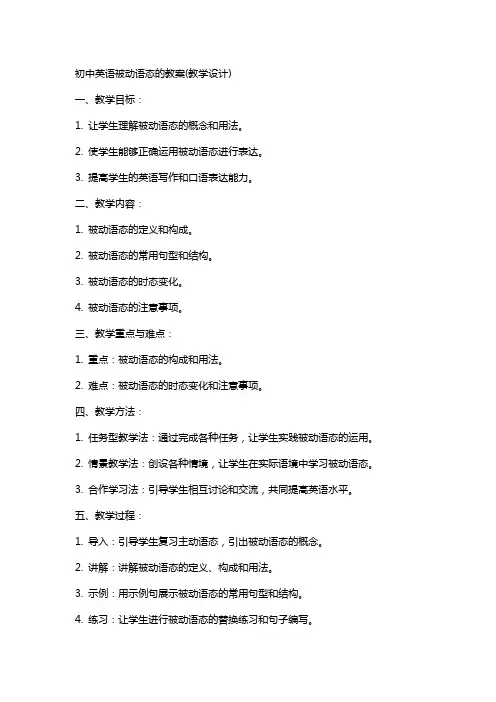
初中英语被动语态的教案(教学设计)一、教学目标:1. 让学生理解被动语态的概念和用法。
2. 使学生能够正确运用被动语态进行表达。
3. 提高学生的英语写作和口语表达能力。
二、教学内容:1. 被动语态的定义和构成。
2. 被动语态的常用句型和结构。
3. 被动语态的时态变化。
4. 被动语态的注意事项。
三、教学重点与难点:1. 重点:被动语态的构成和用法。
2. 难点:被动语态的时态变化和注意事项。
四、教学方法:1. 任务型教学法:通过完成各种任务,让学生实践被动语态的运用。
2. 情景教学法:创设各种情境,让学生在实际语境中学习被动语态。
3. 合作学习法:引导学生相互讨论和交流,共同提高英语水平。
五、教学过程:1. 导入:引导学生复习主动语态,引出被动语态的概念。
2. 讲解:讲解被动语态的定义、构成和用法。
3. 示例:用示例句展示被动语态的常用句型和结构。
4. 练习:让学生进行被动语态的替换练习和句子编写。
5. 拓展:讲解被动语态的时态变化和注意事项。
6. 实践:创设情境,让学生在实际语境中运用被动语态。
8. 作业:布置相关作业,让学生巩固所学知识。
9. 反馈:及时了解学生的学习情况,进行针对性的辅导。
10. 评价:对学生的学习成果进行评价,鼓励优秀学生,激励后进生。
六、教学评价:1. 课堂参与度:观察学生在课堂活动中的参与情况,是否积极回答问题,主动完成任务。
2. 练习完成情况:检查学生作业和练习的完成质量,是否能够正确运用被动语态。
3. 口语表达:在课堂互动和情景模拟中,评估学生使用被动语态的准确性和流畅性。
4. 小组讨论:评估学生在小组讨论中的表现,是否能够相互协作,共同完成任务。
七、教学资源:1. 教材:选用合适的英语教材,提供被动语态的相关知识点。
2. 多媒体课件:制作课件,通过图片、动画等形式展示被动语态的用法。
3. 练习题库:准备丰富的练习题,包括替换练习、填空练习、句子编写等。
4. 情景模拟:设计各种真实情境,让学生在模拟环境中学习被动语态。

被动语态一、相关概念1.含义:语态是动词的一种形式,用来说明句子中主语和谓语动词的关系.如果主语是动词的执行者,则使用语态,如果主语是动作的承受者,则使用语态,在句中,不强调动作的执行者时,通常使用语态.2.主动语态变被动语态主动语态:The boy broke the window yesterday.↓↓ 动作执行者动词主动形式动作承受者被动语态: The window was broken by the boy yesterday.动作承受者动词被动形式动作执行者3.构成:(1)肯定句:主语+ be + done(过去分词) + (by...).·英语被许多人说.English many people.(2)否定句:主语+ be not + done(过去分词) + (by...).·这条路不经常被使用.This road very often.(3)一般疑问句:Be+主语+done(过去分词)+(by...)?·那座桥是被建在长江上吗? that bridge over the Changjiang River?(4)特殊疑问句:疑问词+be+主语+done(过去分词)+(by...)?·电话是什么时候被发明的? the telephone ?4.知识拓展:注意人称,时态和数的变化.(以give为例)时态主动语态被动语态结构一般现在时give/gives一般过去时gave现在进行时is/am/are giving过去进行时was/were giving一般将来时shall/will give现在完成时have/has given情态动词must/can/may give二、主动语态变被动语态的几种特殊情况和注意事项:1.主动形式表示被动含义(主表被)①动词(表示主语的属性特征)+副词(well/badly/easily...),当他们与相应的副词连用的时候用主动表示被动.此类动词有:write, sell, clean, wash等词作不及物动词时,如:The book sells well.·这种食物尝起来好卖的也好. This food tastes and well.·这支笔写的很糟/很流畅. This pen badly/smoothly.·这家商店八点营业. The shop at 8 AM.②want/need + doing 相当于want/need + to be done.·你的衣服需要洗. Your clothes need . = Y our clothesneed .③在be worth doing中,doing表被动意义.·This book is worth .(read) ·This stamp is worth .(collect)2.feel, listen to, hear, let, make, have, see, look at, watch, notice动词后作宾补的不定式都不带to;但改成被动语态后必须带to.(to还原)·The boss made him work all day. He all day(by the boss).·I often hear her sing this song. She often this song(by me).3.动词短语变为被动语态时,不能丢掉动词后的介词或者副词. 【介不丢】·She takes care of the baby every day. The baby by her every day.·People should speak to the old politely. The old politely by people.小练笔:This dictionary mustn’t the library.A. take awayB. be taken awayC. be taken away from4.用于词组的被动语态,常用于表示“据说”或者“相信”,例如:It is said that... (据说) It is reported that... (据报道) It is well-known that... (众所周知)5.含有情态动词的被动语态主语+情态动词+be+动词的过去分词(+by+动作执行者)·他能够被找到. can by .·指南针可以在任何天气中被使用.The compass in any weather.6.含双宾语的主动结构变为被动结构时:(1)将宾语变为主语,宾语保持不变.·He told us a story → were a story by .(2)将宾语变为主语,宾语用介词to/for引导.·He told us a story → told us by him.·Her mother gave her a new pen. →A new pen her by her mom.知识巩固:填介词(to/for)explain/bring/give/lend/offer/pass/sell/send/show/take/teach/tell/write/return/serve sth. sb.design/build/buy/cook/do/draw/make/order/choose/find/get/prepare sth. sb.7.不用于被动语态的情况(1)不及物动词无被动语态.如:appear, die, end, fail, happen, sit, stand, come true, fell asleep, take place等.小练笔:Great changes in the last 3 years.A. have taken placeB. have been taken placeC. have happened·昨天这个城镇发生了一场事故. An accident in this town yesterday.(2)系动词无被动语态.如:be, become, feel, get, grow, keep, look, seem, smell, sound, stay, turn等.·它听起来很好。
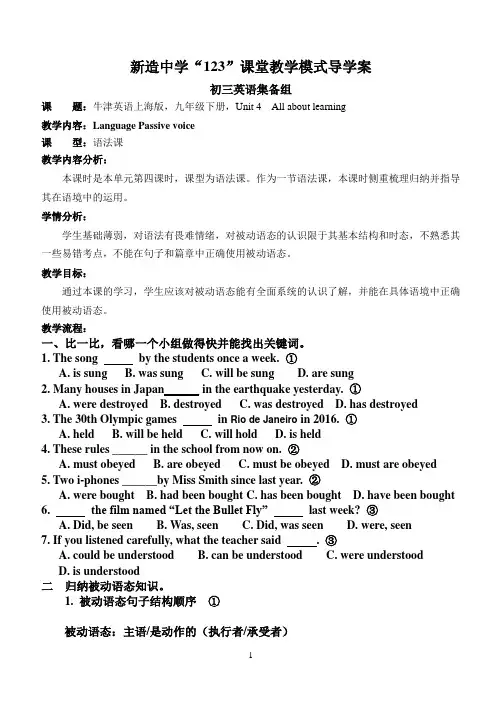
新造中学“123”课堂教学模式导学案初三英语集备组课题:牛津英语上海版,九年级下册,Unit 4 All about learning教学内容:Language Passive voice课型:语法课教学内容分析:本课时是本单元第四课时,课型为语法课。
作为一节语法课,本课时侧重梳理归纳并指导其在语境中的运用。
学情分析:学生基础薄弱,对语法有畏难情绪,对被动语态的认识限于其基本结构和时态,不熟悉其一些易错考点,不能在句子和篇章中正确使用被动语态。
教学目标:通过本课的学习,学生应该对被动语态能有全面系统的认识了解,并能在具体语境中正确使用被动语态。
教学流程:一、比一比,看哪一个小组做得快并能找出关键词。
1. The song by the students once a week.①A. is sungB. was sungC. will be sungD. are sung2. Many houses in Japan______ in the earthquake yesterday.①A. were destroyedB. destroyedC. was destroyedD. has destroyed3. The 30th Olympic games in Rio de Janeiro in 2016.①A. heldB. will be heldC. will holdD. is held4. These rules ______ in the school from now on.②A. must obeyedB. are obeyedC. must be obeyedD. must are obeyed5. Two i-phones ______by Miss Smith since last year.②A. were boughtB. had been boughtC. has been boughtD. have been bought6. the film named “Let the Bullet Fly” last week?③A. Did, be seenB. Was, seenC. Did, was seenD. were, seen7. If you listened carefully, what the teacher said . ③A. could be understoodB. can be understoodC. were understoodD. is understood二归纳被动语态知识。
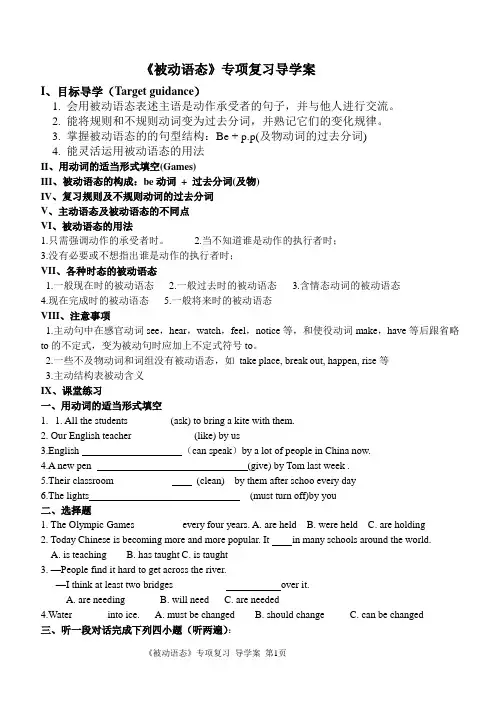
《被动语态》专项复习导学案I、目标导学(Target guidance)1. 会用被动语态表述主语是动作承受者的句子,并与他人进行交流。
2. 能将规则和不规则动词变为过去分词,并熟记它们的变化规律。
3. 掌握被动语态的的句型结构:Be + p.p(及物动词的过去分词)4. 能灵活运用被动语态的用法II、用动词的适当形式填空(Games)III、被动语态的构成:be动词+ 过去分词(及物)IV、复习规则及不规则动词的过去分词V、主动语态及被动语态的不同点VI、被动语态的用法1.只需强调动作的承受者时。
2.当不知道谁是动作的执行者时;3.没有必要或不想指出谁是动作的执行者时;VII、各种时态的被动语态1.一般现在时的被动语态2.一般过去时的被动语态3.含情态动词的被动语态4.现在完成时的被动语态5.一般将来时的被动语态VIII、注意事项1.主动句中在感官动词see,hear,watch,feel,notice等,和使役动词make,have等后跟省略to的不定式,变为被动句时应加上不定式符号to。
2.一些不及物动词和词组没有被动语态,如take place, break out, happen, rise等3.主动结构表被动含义IX、课堂练习一、用动词的适当形式填空1. 1. All the students ________(ask) to bring a kite with them.2. Our English teacher ____________(like) by us3.English ____ (can speak)by a lot of people in China now.4.A new pen (give) by Tom last week .5.Their classroom ___________ (clean) by them after schoo every day6.The lights (must turn off)by you二、选择题1. The Olympic Games _________every four years. A. are held B. were held C. are holding2. Today Chinese is becoming more and more popular. It __ in many schools around the world.A. is teachingB. has taughtC. is taught3. —People find it hard to get across the river.—I think at least two bridges __________ over it.A. are needingB. will needC. are needed4.Water ______ into ice. A. must be changed B. should change C. can be changed三、听一段对话完成下列四小题(听两遍):( )11.What are they talking about? A. A camera B. A radio C. An Mp3 player ( ) 12. What’s it used for?A. It’s used for helping us to improve our EnglishB. It’s used for helping us to listen to musicC. It’s used for helping us to do other things( )13. When was it developed? A. Around 1973 B. Around 1998 C. Around 1975 ( ) 14. Where was it developed A. In Korea B. In Japan C. In Americ1X、课后练习:一.用动词的适当形式填空1.Their classroom often (clean) by them after school.2.A new pen (give) by Tom last week .3.English (can speak )by a lot of people in China now.4.English (learn) for about two years.5.These story-books (read)next month.二、选择题( ) 1. My pencil ___ the day before yesterday.A. found B. was found C. were found ( ) 2. His letter ________ soon. A. will finish B. was finished C. will be finished ( ) 3. The work ___ well ___ and my mother smiled.A. is, done B. was done C. will be, done ( ) 4. A new lab building __ _in their school in a year.A. puts upB. was put upC. will be put up( ) 5. ___ Chinese ____ by the largest number of people in the world.A. Is, spokenB. Was, spokenC. Were, spoken( ) 6. The bottle ___ with medicine by the nurse. A. was filled B. was filling C. was full ( ) 7. Today many trees are being cut in our country. So more trees ____ .A. must plantB. must be plantC. must be planted( ) 8. Man-made satellites ___ into space by many countries since 1960.A. have sent upB. have been sent upC. has been send up( ) 9. ___ the homework ____ the day after tomorrow?A. May, be handed inB. Maybe, handed inC. May, hand in( ) 10. My father _____ not to smoke any more. A. told B. is told C. are told。
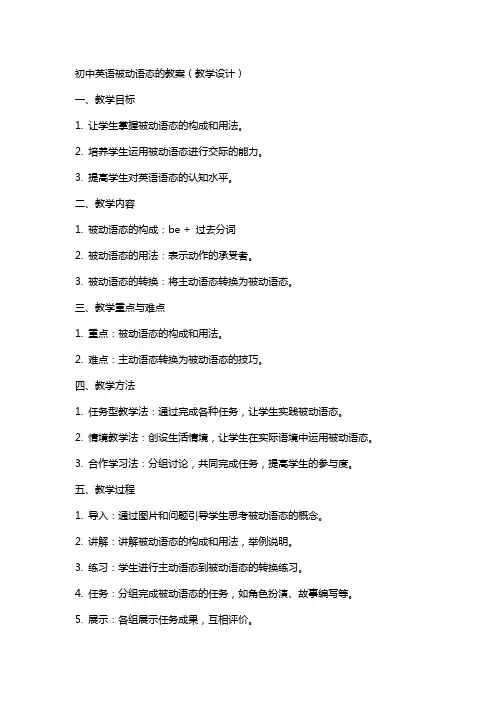
初中英语被动语态的教案(教学设计)一、教学目标1. 让学生掌握被动语态的构成和用法。
2. 培养学生运用被动语态进行交际的能力。
3. 提高学生对英语语态的认知水平。
二、教学内容1. 被动语态的构成:be + 过去分词2. 被动语态的用法:表示动作的承受者。
3. 被动语态的转换:将主动语态转换为被动语态。
三、教学重点与难点1. 重点:被动语态的构成和用法。
2. 难点:主动语态转换为被动语态的技巧。
四、教学方法1. 任务型教学法:通过完成各种任务,让学生实践被动语态。
2. 情境教学法:创设生活情境,让学生在实际语境中运用被动语态。
3. 合作学习法:分组讨论,共同完成任务,提高学生的参与度。
五、教学过程1. 导入:通过图片和问题引导学生思考被动语态的概念。
2. 讲解:讲解被动语态的构成和用法,举例说明。
3. 练习:学生进行主动语态到被动语态的转换练习。
4. 任务:分组完成被动语态的任务,如角色扮演、故事编写等。
5. 展示:各组展示任务成果,互相评价。
6. 总结:教师点评,强调被动语态的重要性和运用技巧。
7. 作业:布置相关练习,巩固所学内容。
六、教学评价1. 课堂参与度:观察学生在课堂活动中的参与程度,了解他们对被动语态的理解和运用情况。
2. 任务完成情况:评估学生在任务中的表现,检查被动语态的运用是否准确。
3. 作业完成情况:检查学生作业中被动语态的运用是否正确,巩固所学知识。
七、教学拓展1. 对比主动语态和被动语态:分析两种语态的异同,帮助学生更好地理解和运用。
2. 被动语态的实际应用:介绍passive voice 在日常生活中的实际应用,提高学生对语态的敏感度。
八、教学反思1. 课堂活动是否有助于学生对被动语态的理解和运用?2. 教学方法是否适合学生的学习需求?3. 针对不同学生的学习情况,如何调整教学策略?九、课后作业1. 练习题:完成相关被动语态的练习题,巩固所学知识。
2. 实践任务:与同学合作,用被动语态编写一个小故事或进行角色扮演。
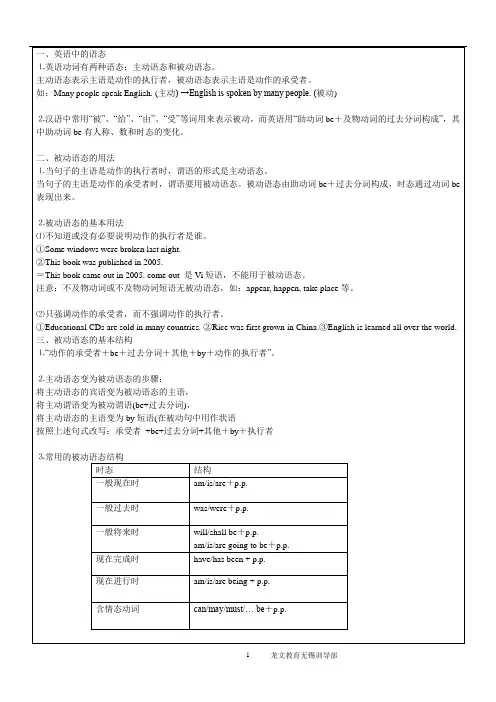
一、英语中的语态⒈英语动词有两种语态:主动语态和被动语态。
主动语态表示主语是动作的执行者,被动语态表示主语是动作的承受者。
如:Many people speak English. (主动) →English is spoken by many people. (被动)⒉汉语中常用“被”、“给”、“由”、“受”等词用来表示被动,而英语用“助动词be+及物动词的过去分词构成”,其中助动词be有人称、数和时态的变化。
二、被动语态的用法⒈当句子的主语是动作的执行者时,谓语的形式是主动语态。
当句子的主语是动作的承受者时,谓语要用被动语态。
被动语态由助动词be+过去分词构成,时态通过动词be 表现出来。
⒉被动语态的基本用法⑴不知道或没有必要说明动作的执行者是谁。
①Some windows were broken last night.②This book was published in 2005.=This book came out in 2005. come out 是Vi短语,不能用于被动语态。
注意:不及物动词或不及物动词短语无被动语态,如:appear, happen, take place等。
⑵只强调动作的承受者,而不强调动作的执行者。
①Educational CDs are sold in many countries. ②Rice was first grown in China.③English is learned all over the world.三、被动语态的基本结构⒈“动作的承受者+be+过去分词+其他+by+动作的执行者”。
⒉主动语态变为被动语态的步骤:将主动语态的宾语变为被动语态的主语,将主动谓语变为被动谓语(be+过去分词),将主动语态的主语变为by短语(在被动句中用作状语按照上述句式改写:承受者+be+过去分词+其他+by+执行者⒊常用的被动语态结构时态结构一般现在时am/is/are+p.p.一般过去时was/were+p.p.一般将来时will/shall be+p.p.am/is/are going to be+p.p.现在完成时have/has been + p.p.现在进行时am/is/are being + p.p.含情态动词can/may/must/… be+p.p.注意:情态动词的被动语态结构为:情态动词+be+过去分词其时态及句型的变化仅由情态动词完成,"be+过去分词"部分不变。
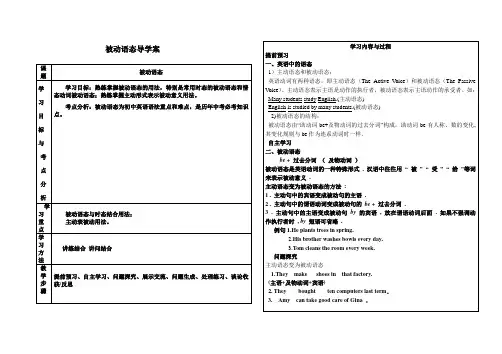
被动语态导学案课题被动语态学习目标与考点分析学习目标:熟练掌握被动语态的用法,特别是常用时态的被动语态和情态动词被动语态;熟练掌握主动形式表示被动意义用法。
考点分析:被动语态为初中英语语法重点和难点,是历年中考必考知识点。
学习重点被动语态与时态结合用法;主动表被动用法。
学习方法讲练结合讲问结合教学步骤提前预习、自主学习、问题探究、展示交流、问题生成、处理练习、谈论收获/反思学习内容与过程提前预习一、英语中的语态1)主动语态和被动语态:英语动词有两种语态,即主动语态(The Active V oice)和被动语态(The PassiveV oice)。
主动语态表示主语是动作的执行者,被动语态表示主语动作的承受者。
如:Many students study English.(主动语态)English is studied by many students.(被动语态)2)被动语态的结构:被动语态由“助动词be+及物动词的过去分词”构成,助动词be有人称、数的变化,其变化规则与be作为连系动词时一样。
自主学习二、被动语态be + 过去分词(及物动词)被动语态是英语动词的一种特殊形式. 汉语中往往用“被”“受”“给”等词来表示被动意义.主动语态变为被动语态的方法:1 . 主动句中的宾语变成被动句的主语.2 . 主动句中的谓语动词变成被动句的be + 过去分词.3 . 主动句中的主语变成被动句by的宾语, 放在谓语动词后面. 如果不强调动作执行者时, by 短语可省略.例句1.He plants trees in spring.2.His brother washes bowls every day.3.Tom cleans the room every week.问题探究主动语态变为被动语态1.They make shoes in that factory.(主语+及物动词+宾语)2. They bought ten computers last term.3. Amy can take good care of Gina .三、常用的被动语态结构时态结构一般现在时am/is/are+p.p.一般过去时was/were+p.p.注意:情态动词的被动语态结构为:情态动词+be+过去分词问题生成四、主动语态变成被动语态时要注意以下几点:1 . 含有双宾语的主动句变成被动句时, 可以将其中一个宾语变为主语, 另一个不动. 一般把间接宾语变为主语.如: Mary gave me a pen .I was given a pen by Mary .如果把直接宾语变为主语, 则在间接宾语前加“ to \for”如: A pen was given to me by Mary .2 .含有复合宾语的主动句变为被动句时, 将其中的宾语变为主语, 宾补不变.如: We asked him to speak at the meeting .He was asked to speak at the meeting .3 . 如果主动句中的谓语是短语动词, 变为被动句时, 短语动词的介词或副词不可以丢掉.如: They took good care of the boys .The boys were taken good care of .4 . 在“ let , make , see , hear , notice , watch , feel ”等动词后面做宾语补足语的动词不定式不带“ to ” , 但改成被动句时应加上“ to ” .如: The doctor made me stay in bed for three days . I was made to stay in bed for three days by the doctor . 课堂训练:1 . He tells us a story every evening .2. He bought me a new bike yesterday.3 . Can he take his sister to the park ?4 . He found out the lost key .5. The boss made him do the heavy work.6. We often hear him play the guitar.五、不用被动语态的动词:1. 不及物动词(vi.) 如:happen, take place, appear, dissapear, …A traffic accident ________(happen) just now.2. 连系动词(Link.v.) 如:be, look, seem, feel, sound, smell, taste, get, turn,become…Peking Opera ________ (sound) beautiful.3. 当此动词表示事物的自然属性的时候:The pen _________ (write) very fast.This kind of sweater _______ (sell) well.课堂训练:1)Teenagers should _____ (allow) to go out at night.2)The telephone _____ (invent) by Bell.3) English ____ (speak) in China.4) The car ____ (make) in China.5) The room must _____ (clean) every day.课后反思:。
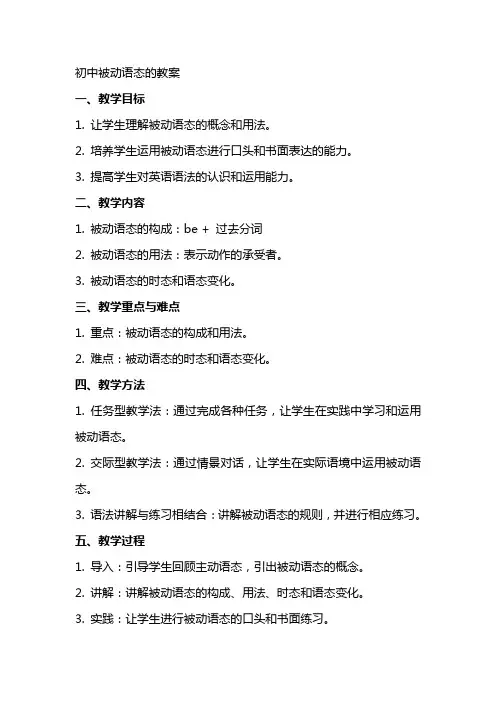
初中被动语态的教案一、教学目标1. 让学生理解被动语态的概念和用法。
2. 培养学生运用被动语态进行口头和书面表达的能力。
3. 提高学生对英语语法的认识和运用能力。
二、教学内容1. 被动语态的构成:be + 过去分词2. 被动语态的用法:表示动作的承受者。
3. 被动语态的时态和语态变化。
三、教学重点与难点1. 重点:被动语态的构成和用法。
2. 难点:被动语态的时态和语态变化。
四、教学方法1. 任务型教学法:通过完成各种任务,让学生在实践中学习和运用被动语态。
2. 交际型教学法:通过情景对话,让学生在实际语境中运用被动语态。
3. 语法讲解与练习相结合:讲解被动语态的规则,并进行相应练习。
五、教学过程1. 导入:引导学生回顾主动语态,引出被动语态的概念。
2. 讲解:讲解被动语态的构成、用法、时态和语态变化。
3. 实践:让学生进行被动语态的口头和书面练习。
4. 反馈:检查学生的练习情况,及时给予指导和纠正。
5. 总结:对本节课的内容进行总结,布置作业。
教案示例:教学目标:1. 让学生理解被动语态的概念和用法。
2. 培养学生运用被动语态进行口头和书面表达的能力。
3. 提高学生对英语语法的认识和运用能力。
教学内容:1. 被动语态的构成:be + 过去分词2. 被动语态的用法:表示动作的承受者。
3. 被动语态的时态和语态变化。
教学重点与难点:1. 重点:被动语态的构成和用法。
2. 难点:被动语态的时态和语态变化。
教学方法:1. 任务型教学法:通过完成各种任务,让学生在实践中学习和运用被动语态。
2. 交际型教学法:通过情景对话,让学生在实际语境中运用被动语态。
3. 语法讲解与练习相结合:讲解被动语态的规则,并进行相应练习。
教学过程:1. 导入:引导学生回顾主动语态,引出被动语态的概念。
2. 讲解:讲解被动语态的构成、用法、时态和语态变化。
3. 实践:让学生进行被动语态的口头和书面练习。
4. 反馈:检查学生的练习情况,及时给予指导和纠正。
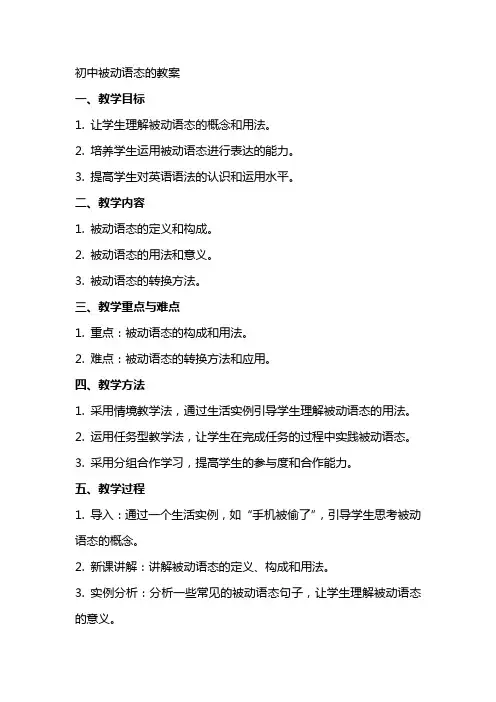
初中被动语态的教案一、教学目标1. 让学生理解被动语态的概念和用法。
2. 培养学生运用被动语态进行表达的能力。
3. 提高学生对英语语法的认识和运用水平。
二、教学内容1. 被动语态的定义和构成。
2. 被动语态的用法和意义。
3. 被动语态的转换方法。
三、教学重点与难点1. 重点:被动语态的构成和用法。
2. 难点:被动语态的转换方法和应用。
四、教学方法1. 采用情境教学法,通过生活实例引导学生理解被动语态的用法。
2. 运用任务型教学法,让学生在完成任务的过程中实践被动语态。
3. 采用分组合作学习,提高学生的参与度和合作能力。
五、教学过程1. 导入:通过一个生活实例,如“手机被偷了”,引导学生思考被动语态的概念。
2. 新课讲解:讲解被动语态的定义、构成和用法。
3. 实例分析:分析一些常见的被动语态句子,让学生理解被动语态的意义。
4. 练习环节:设计一些练习题,让学生运用被动语态进行表达。
5. 小组讨论:分组讨论如何将主动语态句子转换为被动语态句子。
6. 总结与反馈:对本节课的内容进行总结,并对学生的表现进行反馈。
7. 课后作业:布置一些有关被动语态的练习题,巩固所学知识。
六、教学评价1. 评价方式:课堂参与、练习完成情况、小组讨论表现。
2. 评价内容:被动语态的构成、用法和转换能力。
3. 评价标准:能正确运用被动语态进行表达,理解被动语态的意义,能将主动语态句子转换为被动语态句子。
七、教学拓展1. 引导学生了解被动语态在实际生活中的应用,提高学生对被动语态的认识。
2. 鼓励学生阅读和欣赏含有被动语态的英语文章,提高学生的语感。
3. 布置一些有关被动语态的趣味性练习,激发学生的学习兴趣。
八、教学反思1. 反思教学内容:是否全面讲解被动语态的定义、用法和转换方法。
2. 反思教学过程:是否能激发学生的学习兴趣,提高学生的参与度。
3. 反思教学方法:是否能有效帮助学生理解和运用被动语态。
4. 反思教学评价:是否能全面、准确地评价学生的学习效果。
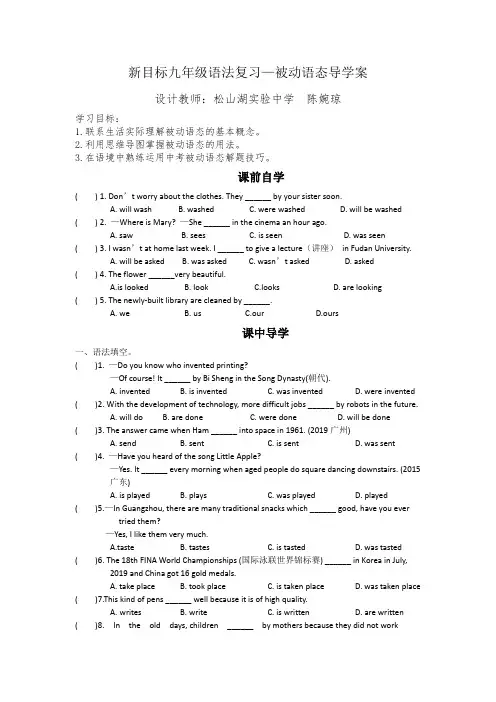
新目标九年级语法复习—被动语态导学案设计教师:松山湖实验中学陈婉琼学习目标:1.联系生活实际理解被动语态的基本概念。
2.利用思维导图掌握被动语态的用法。
3.在语境中熟练运用中考被动语态解题技巧。
课前自学( ) 1. Don’t worry about the clothes. They ______ by your sister soon.A. will washB. washedC. were washedD. will be washed ( ) 2. —Where is Mary? —She ______ in the cinema an hour ago.A. sawB. seesC. is seenD. was seen( ) 3. I wasn’t at home last week. I ______ to give a lecture(讲座)in Fudan University.A. will be askedB. was askedC. wasn’t askedD. asked( ) 4. The flower ______very beautiful.A.is lookedB. lookC.looksD. are looking( ) 5. The newly-built library are cleaned by ______.A. weB. usC.ourD.ours课中导学一、语法填空。
()1. —Do you know who invented printing?—Of course! It ______ by Bi Sheng in the Song Dynasty(朝代).A. inventedB. is inventedC. was inventedD. were invented ()2. With the development of technology, more difficult jobs ______ by robots in the future.A. will doB. are doneC. were doneD. will be done()3. The answer came when Ham ______ into space in 1961. (2019广州)A. sendB. sentC. is sentD. was sent()4. —Have you heard of the song Little Apple?—Yes. It ______ every morning when aged people do square dancing downstairs. (2015广东)A. is playedB. playsC. was playedD. played()5.—In Guangzhou, there are many traditional snacks which ______ good, have you ever tried them?—Yes, I like them very much.A.tasteB. tastesC. is tastedD. was tasted ()6. The 18th FINA World Championships (国际泳联世界锦标赛) ______ in Korea in July, 2019 and China got 16 gold medals.A. take placeB. took placeC. is taken placeD. was taken place ()7.This kind of pens ______ well because it is of high quality.A.writesB. writeC. is writtenD. are written ( )8.In the old days, children______by mothers because they did not workoutside.A.were taken care ofB. is taken care ofC.was taken careD. are taken care( )9. If you see the cartoon film, you will ______ laugh. (2013内蒙古呼和浩特)A.be madeB. be made toC. make toD. make( )10. A year has four seasons and it ______ twelve different star signs.(2013 甘肃白银)A.divided intoB. is dividedC. dividedD. is divided into( )11. This listening material, together with its CD-ROMs, ______ well. (2013江苏常州)A. sellsB. sellC. is soldD. are sold( )12. This pair of shoes ______ hand, and it ______ very comfortable. (2013湖北黄石)A. is made with; is feltB. are made from; is feltC. are made of; feelsD. is made by; feels二、用所给词的正确形式填空。
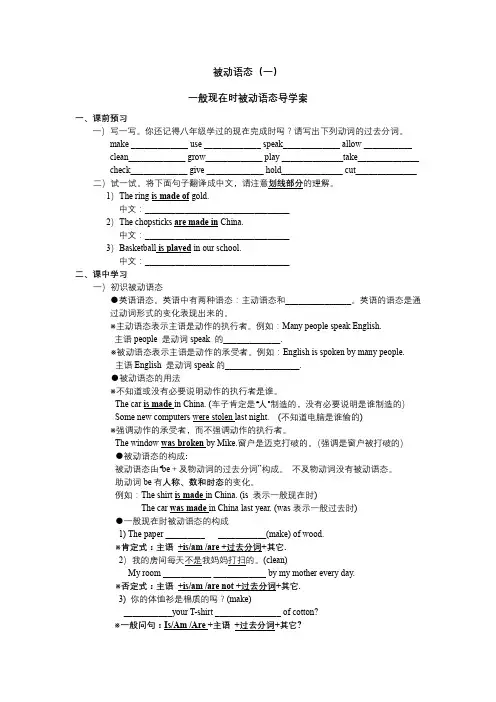
被动语态(一)一般现在时被动语态导学案一、课前预习一)写一写。
你还记得八年级学过的现在完成时吗?请写出下列动词的过去分词。
make _____________ use _____________ speak_____________ allow ___________clean_____________ grow_____________ play ______________take______________check_____________ give _____________ hold______________ cut______________ 二)试一试。
将下面句子翻译成中文,请注意划线部分的理解。
1)The ring is made of gold.中文:_________________________________2)The chopsticks are made in China.中文:_________________________________3)Basketball is played in our school.中文:_________________________________二、课中学习一)初识被动语态●英语语态。
英语中有两种语态:主动语态和_______________。
英语的语态是通过动词形式的变化表现出来的。
※主动语态表示主语是动作的执行者。
例如:Many people speak English.主语people 是动词speak 的_____________.※被动语态表示主语是动作的承受者。
例如:English is spoken by many people.主语English 是动词speak的_________________.●被动语态的用法※不知道或没有必要说明动作的执行者是谁。
The car is made in China. (车子肯定是“人”制造的,没有必要说明是谁制造的)Some new computers were stolen last night. (不知道电脑是谁偷的)※强调动作的承受者,而不强调动作的执行者。
被动语态四川省资阳市雁江区丰裕高级中学一、教学目标:知识与能力:学生能够掌握被动语态的基本结构,主动语态、被动语态的互变;被动语态的时态及用法。
过程与方法:通过比较、讲解、训练使学生学会运用被动语态。
情感态度价值观目标:通过学习,学会变被动学习为主动学习。
二、教学重难点:教学重点:被动语态的基本运用。
教学难点:主动语态和被动语态的互变,被动语态的时态及用法教学准备:多媒体课件三、教学过程the students with each other ,Ask them some simpie questions to lead in the passive voice.2.语态概述英语语态是通过动词形式的变化表现出来,英语中有两种语态:主动语态和被动语态。
主动语态表示主语是动作的执行者。
例如:Many people speak English.He opened the door.他开了门We can repair this watch in two days被动语态表示主语是动作的承受者。
例如:English is spoken by many people.The door was opened.门被开了。
This watch can be repaired by us in two days3、被动语态的构成被动语态由“助动词be +及物动词的过去分词”构成。
助动词Be的变化是通过人称、数和时态的变化表现出来的。
4、被动语态的时态(1)、一般现在时的被动语态:A recorder is used in our English class every day.Footbal 1 is played all over the world.Cameras are used for taking photos.被动语态的构成:be +一般现在时am / is / are + knife is used for cutting.A knife is not used for cutting.Is a knife used for cutting ?Yes, it is ./ No, it isn, t.(2)、一般过去时的被动语态:The bank was lobbed yesteiday.A man-made satellite was sent up into space last year.The shoes were sold out yesterday.The shoes were not sold out yesterday.Were the shoes sold out yesterday ?Yes, they were . No, they weren' t.被动语态的构成:be +一般过去时was / were + (3)、情态动词的被动语态This watch can be repaired in two days.Your book may be taken away.These trees should be planted at once .被动语态的构成:be +情态动词.(must / can / could / may…)+ be + watchcan be repaired in two days.This watch can not be repaired ....Can this watch be repaired in two days?Yes, it can .No, it can' tYour homework must ( finish ) on time.The bad vegetable should not( eat ).Your clothes may( put ) here.All of these maths exercises must ( finish ) today.The work can( do ) in an hour.Teenagers should (not drink) wine.5、Conclusion被动语态:主语是动作的承受者。
四、诊断测试几种特殊的被动语态(一)在主动句中,使役动词、感官动词make, see, hear, watch, notice等词后跟省略to的不定式,变被动语态时,必须还原to.1、I often see him come into the room.He often come into the room.2、The boss made the workers work all day.The workers made work all day.(二)含有双宾语的主动句改为被动句时,应将其中一个宾语改为被动语态的主语,而另一个宾语保留仍作宾语。
将物(sth.)变为被动语态的主语时,要在保留宾语前加介词to或for.常见的双宾语动词如give, offer, pass, show, lend, send, bring, return, tell等用介词to;buy, make(制作), mend, cook, sing, get等用for.1、My father gave me a bike as a birthday present.A bike ____ ____ ____ _____ as a birthday present.I _____ _______ a bike as a birthday present.2、She bought me a pen yesterday.I _____ _____ _____ ______ yesterday.A pen______ ______ _____ ___yesterday.五、合作探究:主动语态变被动语态口诀宾语提前主语变,原主变宾by后见,时态人称be关键六:本课小结。
七、达标测试把下列句子变成被动语态。
1.People use knives for cutting things.Knives ______ ______ for cutting things.2.The students clean the windows of their classroom twice a month.The windows of their classroom______ _______ twice a month.3.I found the ticket on the floor.______ ______ ______ ______ on the floor.4.I told her to return the book in time.She ______ _______ to return the book in time.5. Did you plant many trees at this time last year?_______ ______ _______ _______ at this time last time?6.Must we finish our work today?_______ our work______ _______ today?7. The foreign friends gave us some wonderful stamps.1) _______ ______ _______ some wonderful stamps.2) Some wonderful stamps _______ ________ _______ _______.六:中考链接1. Another man-made satellite was sent up into space by them last week (济南市中考题)——————another man-made satellite into space last week.变主动语态2.People there planted many trees last year.Trees _____ _____ by people there last year.(青岛市中考题)3. They grow vegetables on the farm.The vegetables _______ ______on the farm(上海市中考题)4.The river smells terrible. People must __ dirty thing into it.(南京市中考题)A be stopped to throwB be stopped from throwingC stop to throwD stop from throwing5.This book __ often __from the library.(北京市中考题)A aren’t; take awayB taken awayC isn’t; taken awayD be taken away6.He ____ _____ (tell) to return his books to the library yesterday. (黄冈市中考题)7.The students study German in this school.German _______ ________ by the students in this school.8.Do they often talk about this question?______ this question often _______ about _______ _______?9.He can mend the bike in two days.The bike ______ ______ _______ in two days.10.You must take this medicine three times a day.This medicine _______ _______ ________ three times a day.Exercises:1.Many people speak English.2.People used knives for cutting things.3.We should clean the classroom every day。
初中被动语态英语教案精选推荐随着教育理念的发展和教学技术的不断改进,促进学生语文学习有很多有效方法,而教育者也在不断地尝试着将新的教学方法推广到课堂上,以使学生能够更好地学习知识。
在英语教学中,被动语态作为一种较为重要的语法,对于初中学生而言,它的掌握对于他们未来的英语学习具有重要意义。
从处于英语学习初期的初中生的角度出发,为了更好地掌握被动语态这一内容,教师推荐了以下三篇初中被动语态英语教案。
一、教案一教案一主要目的是通过各种途径来让学生们了解什么是被动语态,并尝试运用被动语态来表达自己所想的意思。
1、活动一:学生自学被动语态让学生根据英语语法书上的相关内容自学被动语态,并在回答问题和给出例子的过程中深入理解什么是被动语态及其在语言学习中的重要性。
2、活动二:被动语态句子匹配活动中,学生们将被放置在三个不同的工作站中。
工作站一是动词变位工作站,工作站二是被动语态句子搜集工作站,工作站三是词组和搭配搜集工作站。
学生们将在三个工作站中轮流尝试找到句子和变位方式,并在一张表格上写下它们的对应关系。
3、活动三:运用被动语态活动中,每个学生将从一个小组中随机选择一个名词。
小组中的每个学生都要利用这个名词来编造一个被动语态句子。
二、教案二教案二主要关注在学生自己写出完整的被动语态句子,并能够分析其中的语法规则和应用场景。
1、学生分析被动语态老师通过对一些例子进行分析,并讨论其应用场景和语法规则,让学生对被动语态有了更深入的认识。
2、学生写出被动句子此活动将要求学生根据给定的句子以及语法规则自己编写由被动语态构成的新句子。
过程中老师会适时地提供帮助。
3、学生互相评估活动中,学生将互相评估,并对其他同学所写的句子进行修改。
在这个环节中,学生将需要注意语法错误和单词拼写错误。
三、教案三教案三主要在于讲解被动语态的用法,并让学生尝试翻译一些较长的句子。
1、特别组织老师将学生分为几个特别组织,每个组织将会得到一个有别于其他组别的被动语态句子,并要通过自己的语言能力翻译出这个句子。
《被动语态》语法课导学案班级:初二(2)班教师:一、复习:将动词变为过去分词,并组成动宾短语。
为被动语态的学习做好铺垫。
二、导入环节:通过一幅图片,让学生了解“主动”与“被动”的关系,从而导入新课内容。
三、语法的讲练过程:依次讲解五种常见的被动语态的结构,并紧跟练习,从而讲练结合,保证效果。
四、知识巩固:用两种题型检测学生对于所学知识的掌握情况,从而巩固被动语态的知识,承上启下,为被动语态的运用做好准备。
(壱)找出以下的错误,并改正。
1. The bank robbers were catched by the police.2. A house can be maken easily3. English is not teached at this school.4. His homework is never did.5. The window was broke.(二)将以下句子改成被动语态1. The worker cleaned those cans.Those cans .2. The designer has finished the new products.The new products .3. They can’t cook dinner alone at home.Dinner alone at home.4. Mr.Li painted the picture two year ago.The picture by Mr.Li two years ago.5. Kate will prepare the test.The test by Kate.五、能力提升:看一些不同时间段内关于环境的图片,运用所给动词的正确语态、时态和相关提示,小组合作完成一篇文章。
在写作期间,老师给一些帮助。
通过练习,也培养学生的环保意识。
We only ( 一个地球) 。
We should( 用心呵护它) 。
《被动语态》导学案一、学习目标1、理解被动语态的概念和构成。
2、掌握不同时态下被动语态的形式和用法。
3、能够正确运用被动语态进行句子的转换和写作。
二、知识要点1、被动语态的概念被动语态表示主语是动作的承受者,即行为动作的对象。
例如:“The book was written by him”(这本书是他写的。
)在这个句子中,“the book”是动作“write”的承受者。
2、被动语态的构成被动语态由“be +过去分词”构成。
其中,“be”根据时态的不同而变化,过去分词保持不变。
例如:一般现在时:am/is/are +过去分词一般过去时:was/were +过去分词一般将来时:will be +过去分词现在进行时:am/is/are being +过去分词过去进行时:was/were being +过去分词现在完成时:have/has been +过去分词过去完成时:had been +过去分词3、不同时态下被动语态的形式和用法(1)一般现在时的被动语态结构:am/is/are +过去分词例如:“The flowers are watered every day”(这些花每天都被浇水。
)(2)一般过去时的被动语态结构:was/were +过去分词例如:“The house was built in 1990”(这座房子建于 1990 年。
)(3)一般将来时的被动语态结构:will be +过去分词例如:“The sports meeting will be held next week”(运动会将在下周举行。
)(4)现在进行时的被动语态结构:am/is/are being +过去分词例如:“The bridge is being repaired now”(这座桥正在被修理。
)(5)过去进行时的被动语态结构:was/were being +过去分词例如:“The room was being cleaned when I arrived”(我到达时房间正在被打扫。